Abstract
OBJECTIVE: To investigate the effects of an 18 week walking programme upon cardiac function. METHODS: 29 sedentary or relatively inactive but otherwise healthy subjects (15 walkers and 14 controls, aged 40-68 years) completed the study. The walkers completed a progressive 18 week walking programme which required an estimated average energy expenditure of 900 kcal week-1 for the total duration of the study and 1161 kcal week-1 during the final six weeks. Walking was carried out at an intensity of 67.8 (SD 4.99)% of maximum oxygen consumption and 73.8(6.99%) of maximum heart rate. Before and after the intervention all subjects underwent an M mode echocardiogram, graded treadmill walking test, and step test for the assessment of aerobic fitness. RESULTS: After 18 weeks the results of the control group showed no change in any of the variables measured while the walkers showed a statistically significant increase in the velocity of relaxation of the longitudinal myocardial fibres of the left ventricle and a decrease in heart rate measured during the step tests, indicating an improvement in aerobic capacity. CONCLUSIONS: Walking promotes improvements in cardiovascular fitness. Moderate forms of exercise may improve cardiac function.
Full text
PDF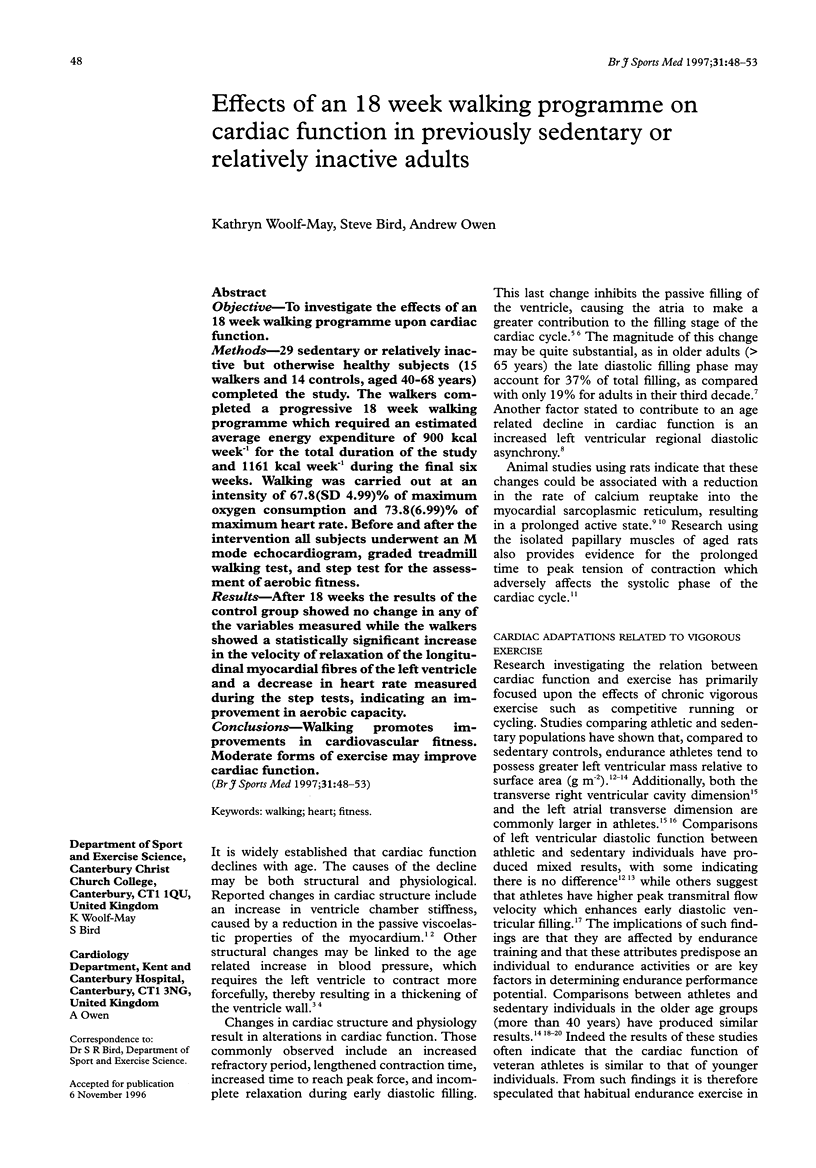
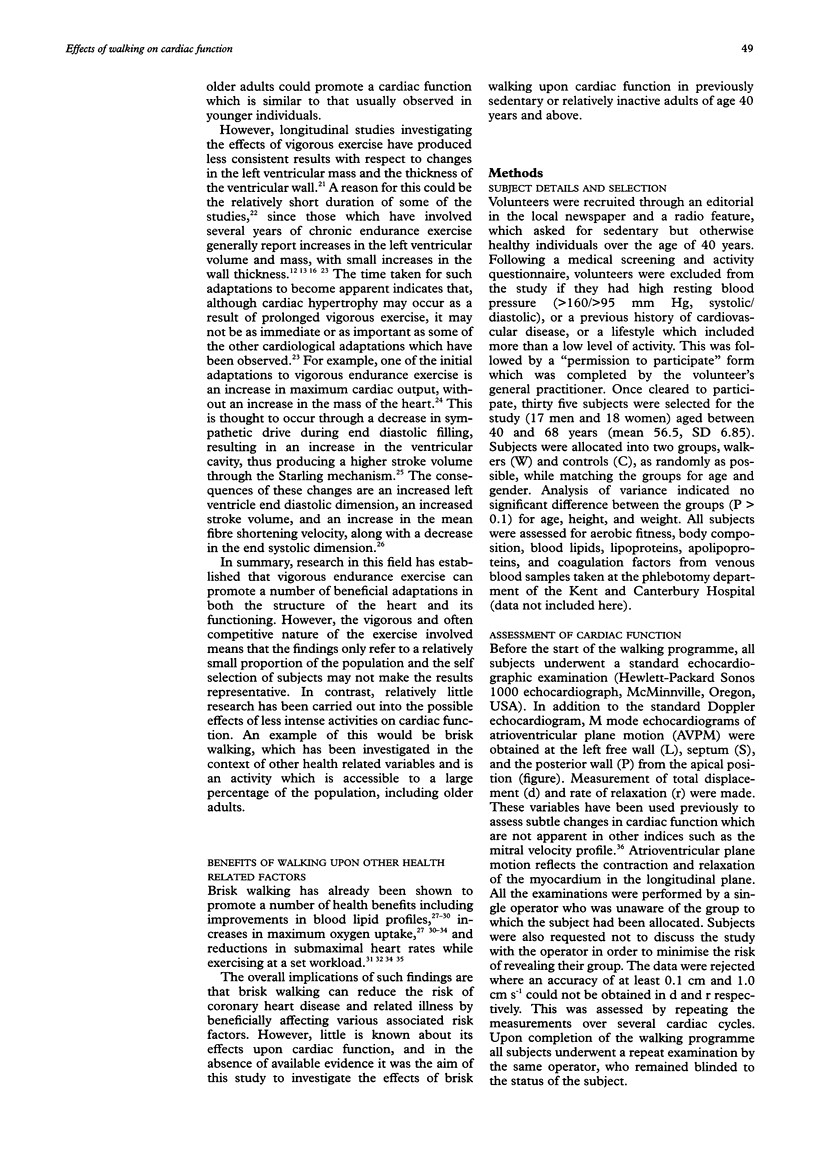
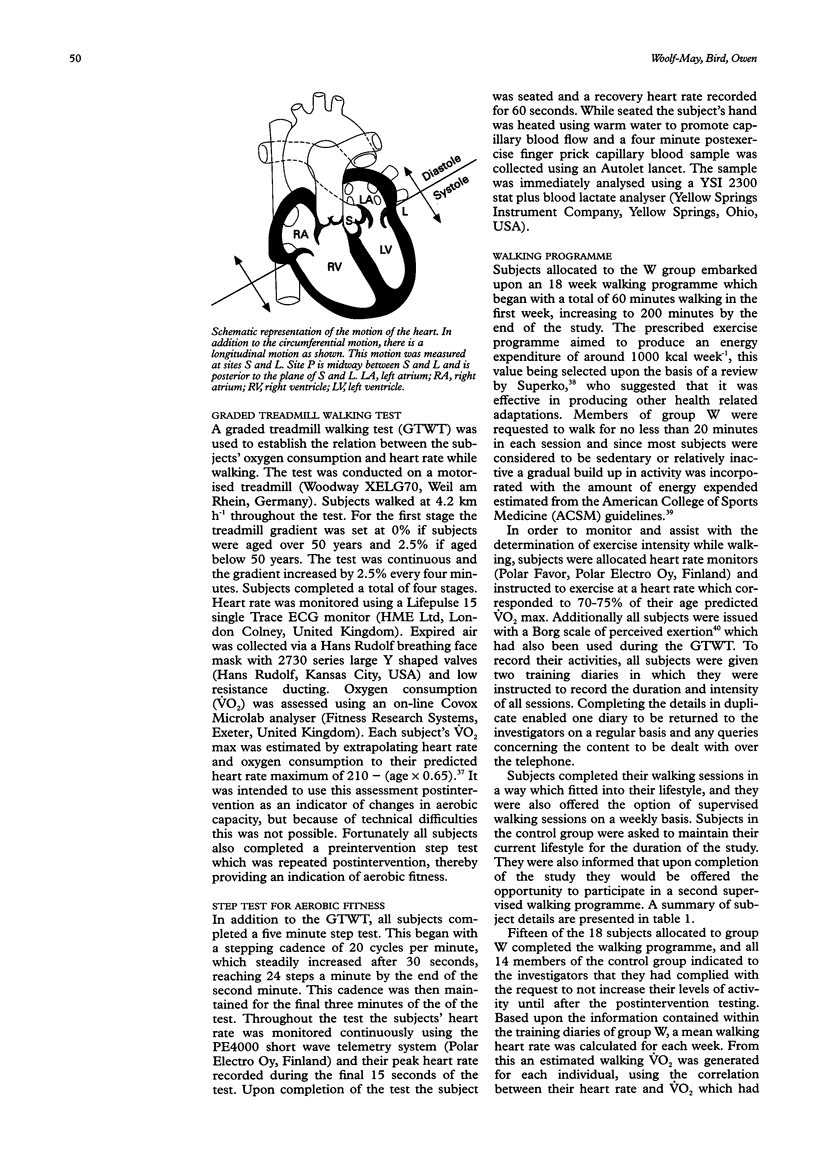
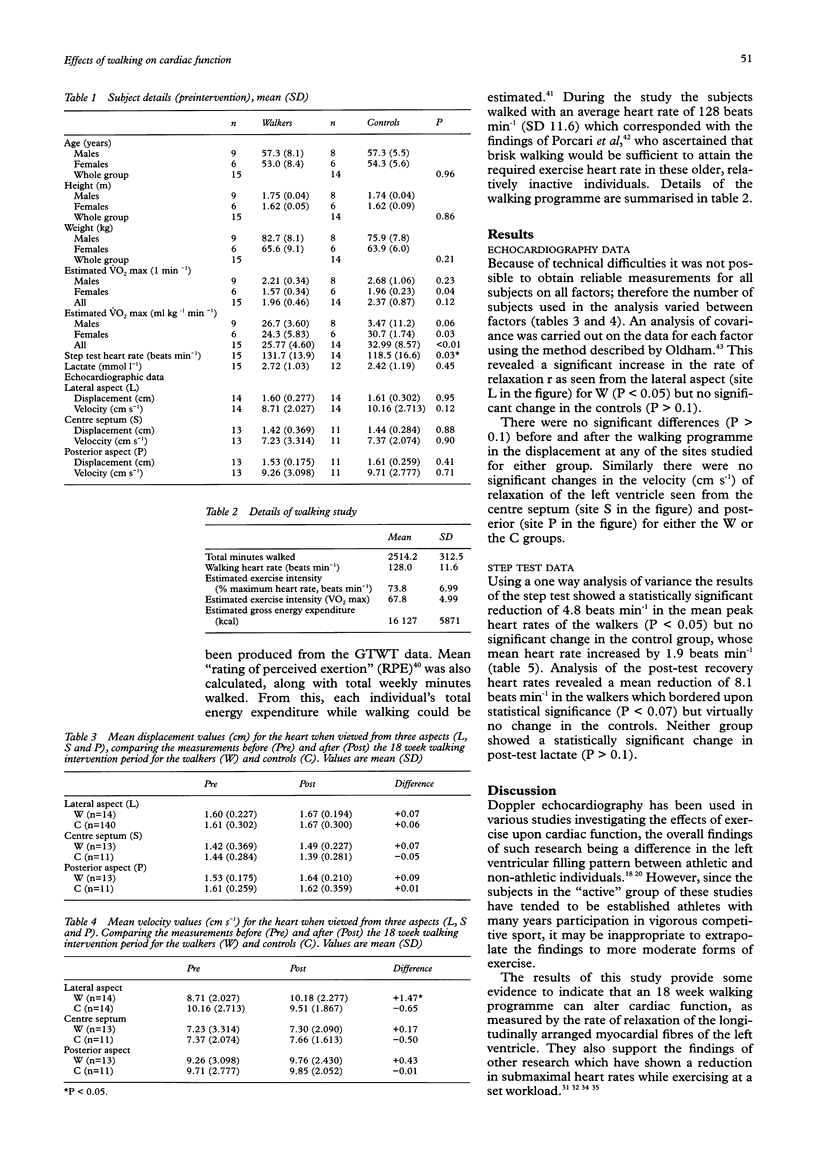
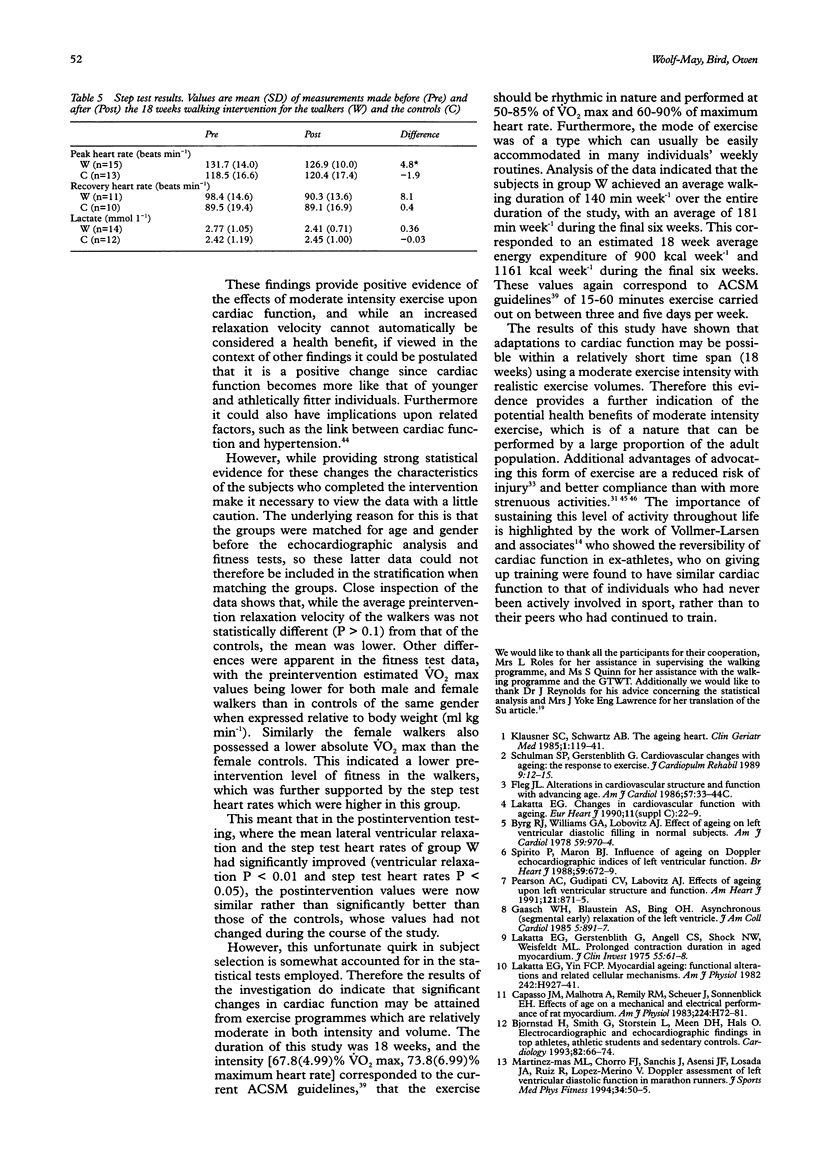
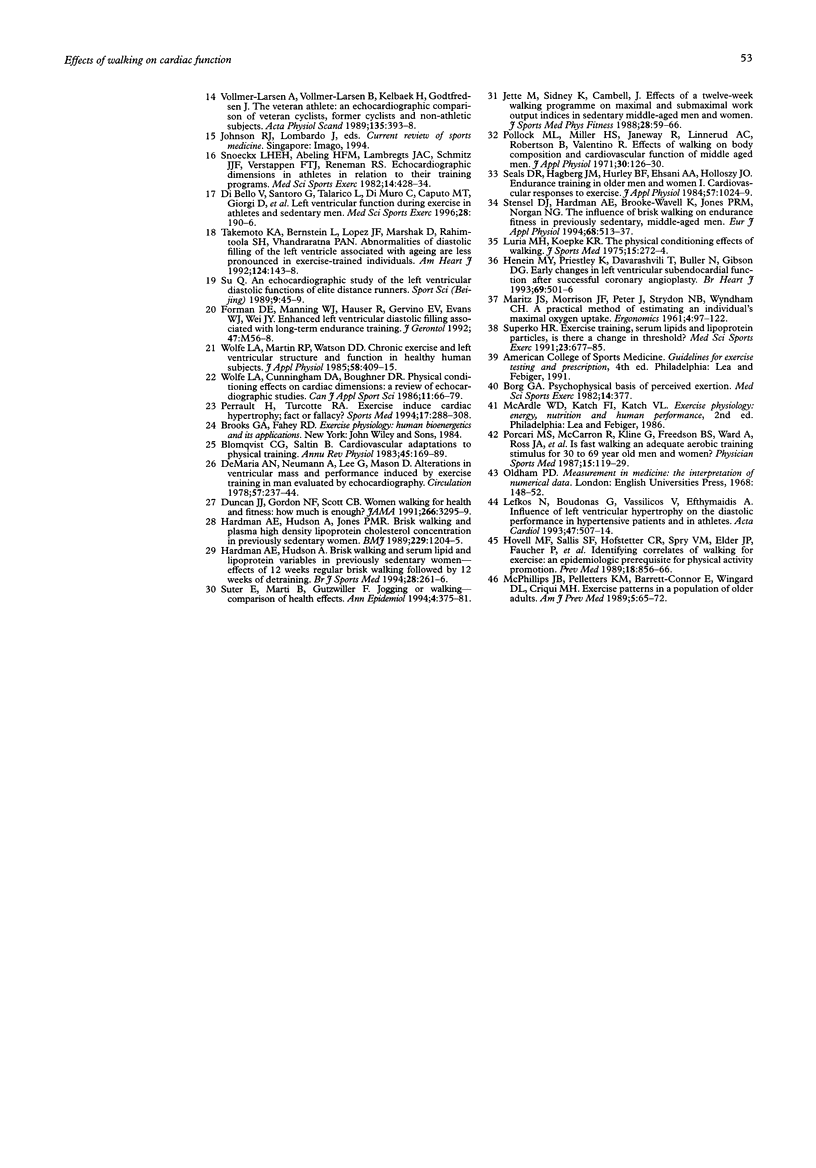
Images in this article
Selected References
These references are in PubMed. This may not be the complete list of references from this article.
- Björnstad H., Smith G., Storstein L., Meen H. D., Hals O. Electrocardiographic and echocardiographic findings in top athletes, athletic students and sedentary controls. Cardiology. 1993;82(1):66–74. doi: 10.1159/000175856. [DOI] [PubMed] [Google Scholar]
- Blomqvist C. G., Saltin B. Cardiovascular adaptations to physical training. Annu Rev Physiol. 1983;45:169–189. doi: 10.1146/annurev.ph.45.030183.001125. [DOI] [PubMed] [Google Scholar]
- Borg G. A. Psychophysical bases of perceived exertion. Med Sci Sports Exerc. 1982;14(5):377–381. [PubMed] [Google Scholar]
- Capasso J. M., Malhotra A., Remily R. M., Scheuer J., Sonnenblick E. H. Effects of age on mechanical and electrical performance of rat myocardium. Am J Physiol. 1983 Jul;245(1):H72–H81. doi: 10.1152/ajpheart.1983.245.1.H72. [DOI] [PubMed] [Google Scholar]
- DeMaria A. N., Neumann A., Lee G., Fowler W., Mason D. T. Alterations in ventricular mass and performance induced by exercise training in man evaluated by echocardiography. Circulation. 1978 Feb;57(2):237–244. doi: 10.1161/01.cir.57.2.237. [DOI] [PubMed] [Google Scholar]
- Di Bello V., Santoro G., Talarico L., Di Muro C., Caputo M. T., Giorgi D., Bertini A., Bianchi M., Giusti C. Left ventricular function during exercise in athletes and in sedentary men. Med Sci Sports Exerc. 1996 Feb;28(2):190–196. doi: 10.1097/00005768-199602000-00006. [DOI] [PubMed] [Google Scholar]
- Duncan J. J., Gordon N. F., Scott C. B. Women walking for health and fitness. How much is enough? JAMA. 1991 Dec 18;266(23):3295–3299. [PubMed] [Google Scholar]
- Forman D. E., Manning W. J., Hauser R., Gervino E. V., Evans W. J., Wei J. Y. Enhanced left ventricular diastolic filling associated with long-term endurance training. J Gerontol. 1992 Mar;47(2):M56–M58. doi: 10.1093/geronj/47.2.m56. [DOI] [PubMed] [Google Scholar]
- Gaasch W. H., Blaustein A. S., Bing O. H. Asynchronous (segmental early) relaxation of the left ventricle. J Am Coll Cardiol. 1985 Apr;5(4):891–897. doi: 10.1016/s0735-1097(85)80429-0. [DOI] [PubMed] [Google Scholar]
- Hardman A. E., Hudson A. Brisk walking and serum lipid and lipoprotein variables in previously sedentary women--effect of 12 weeks of regular brisk walking followed by 12 weeks of detraining. Br J Sports Med. 1994 Dec;28(4):261–266. doi: 10.1136/bjsm.28.4.261. [DOI] [PMC free article] [PubMed] [Google Scholar]
- Hardman A. E., Hudson A., Jones P. R., Norgan N. G. Brisk walking and plasma high density lipoprotein cholesterol concentration in previously sedentary women. BMJ. 1989 Nov 11;299(6709):1204–1205. doi: 10.1136/bmj.299.6709.1204-a. [DOI] [PMC free article] [PubMed] [Google Scholar]
- Henein M. Y., Priestley K., Davarashvili T., Buller N., Gibson D. G. Early changes in left ventricular subendocardial function after successful coronary angioplasty. Br Heart J. 1993 Jun;69(6):501–506. doi: 10.1136/hrt.69.6.501. [DOI] [PMC free article] [PubMed] [Google Scholar]
- Hovell M. F., Sallis J. F., Hofstetter C. R., Spry V. M., Faucher P., Caspersen C. J. Identifying correlates of walking for exercise: an epidemiologic prerequisite for physical activity promotion. Prev Med. 1989 Nov;18(6):856–866. doi: 10.1016/0091-7435(89)90021-2. [DOI] [PubMed] [Google Scholar]
- Jetté M., Sidney K., Campbell J. Effects of a twelve-week walking programme on maximal and submaximal work output indices in sedentary middle-aged men and women. J Sports Med Phys Fitness. 1988 Mar;28(1):59–66. [PubMed] [Google Scholar]
- Klausner S. C., Schwartz A. B. The aging heart. Clin Geriatr Med. 1985 Feb;1(1):119–141. [PubMed] [Google Scholar]
- Lakatta E. G. Changes in cardiovascular function with aging. Eur Heart J. 1990 May;11 (Suppl 100):22–29. doi: 10.1093/eurheartj/11.suppl_c.22. [DOI] [PubMed] [Google Scholar]
- Lakatta E. G., Yin F. C. Myocardial aging: functional alterations and related cellular mechanisms. Am J Physiol. 1982 Jun;242(6):H927–H941. doi: 10.1152/ajpheart.1982.242.6.H927. [DOI] [PubMed] [Google Scholar]
- Lefkos N., Boudonas G., Vassilicos V., Efthymiadis A. Influence of left ventricular hypertrophy on the diastolic performance in hypertensive patients and in athletes. Acta Cardiol. 1993;48(5):507–514. [PubMed] [Google Scholar]
- Luria M. H., Koepke K. R. The physical conditioning effects of walking. J Sports Med Phys Fitness. 1975 Sep;15(3):272–274. [PubMed] [Google Scholar]
- McPhillips J. B., Pellettera K. M., Barrett-Connor E., Wingard D. L., Criqui M. H. Exercise patterns in a population of older adults. Am J Prev Med. 1989 Mar-Apr;5(2):65–72. [PubMed] [Google Scholar]
- Ong L., Green S., Reiser P., Morrison J. Early prediction of mortality in patients with acute myocardial infarction: a prospective study of clinical and radionuclide risk factors. Am J Cardiol. 1986 Jan 1;57(1):33–38. doi: 10.1016/0002-9149(86)90947-1. [DOI] [PubMed] [Google Scholar]
- Pearson A. C., Gudipati C. V., Labovitz A. J. Effects of aging on left ventricular structure and function. Am Heart J. 1991 Mar;121(3 Pt 1):871–875. doi: 10.1016/0002-8703(91)90201-r. [DOI] [PubMed] [Google Scholar]
- Perrault H., Turcotte R. A. Exercise-induced cardiac hypertrophy. Fact or fallacy? Sports Med. 1994 May;17(5):288–308. doi: 10.2165/00007256-199417050-00003. [DOI] [PubMed] [Google Scholar]
- Pollock M. L., Miller H. S., Jr, Janeway R., Linnerud A. C., Robertson B., Valentino R. Effects of walking on body composition and cardiovascular function of middle-aged man. J Appl Physiol. 1971 Jan;30(1):126–130. doi: 10.1152/jappl.1971.30.1.126. [DOI] [PubMed] [Google Scholar]
- Seals D. R., Hagberg J. M., Hurley B. F., Ehsani A. A., Holloszy J. O. Endurance training in older men and women. I. Cardiovascular responses to exercise. J Appl Physiol Respir Environ Exerc Physiol. 1984 Oct;57(4):1024–1029. doi: 10.1152/jappl.1984.57.4.1024. [DOI] [PubMed] [Google Scholar]
- Snoeckx L. H., Abeling H. F., Lambregts J. A., Schmitz J. J., Verstappen F. T., Reneman R. S. Echocardiographic dimensions in athletes in relation to their training programs. Med Sci Sports Exerc. 1982;14(6):428–434. doi: 10.1249/00005768-198206000-00004. [DOI] [PubMed] [Google Scholar]
- Spirito P., Maron B. J. Influence of aging on Doppler echocardiographic indices of left ventricular diastolic function. Br Heart J. 1988 Jun;59(6):672–679. doi: 10.1136/hrt.59.6.672. [DOI] [PMC free article] [PubMed] [Google Scholar]
- Superko H. R. Exercise training, serum lipids, and lipoprotein particles: is there a change threshold? Med Sci Sports Exerc. 1991 Jun;23(6):677–685. [PubMed] [Google Scholar]
- Suter E., Marti B., Gutzwiller F. Jogging or walking--comparison of health effects. Ann Epidemiol. 1994 Sep;4(5):375–381. doi: 10.1016/1047-2797(94)90072-8. [DOI] [PubMed] [Google Scholar]
- Takemoto K. A., Bernstein L., Lopez J. F., Marshak D., Rahimtoola S. H., Chandraratna P. A. Abnormalities of diastolic filling of the left ventricle associated with aging are less pronounced in exercise-trained individuals. Am Heart J. 1992 Jul;124(1):143–148. doi: 10.1016/0002-8703(92)90932-l. [DOI] [PubMed] [Google Scholar]
- Vollmer-Larsen A., Vollmer-Larsen B., Kelbaek H., Godtfredsen J. The veteran athlete: an echocardiographic comparison of veteran cyclists, former cyclists and non-athletic subjects. Acta Physiol Scand. 1989 Mar;135(3):393–398. doi: 10.1111/j.1748-1716.1989.tb08592.x. [DOI] [PubMed] [Google Scholar]
- Wolfe L. A., Cunningham D. A., Boughner D. R. Physical conditioning effects on cardiac dimensions: a review of echocardiographic studies. Can J Appl Sport Sci. 1986 Jun;11(2):66–79. [PubMed] [Google Scholar]
- Wolfe L. A., Martin R. P., Watson D. D., Lasley R. D., Bruns D. E. Chronic exercise and left ventricular structure and function in healthy human subjects. J Appl Physiol (1985) 1985 Feb;58(2):409–415. doi: 10.1152/jappl.1985.58.2.409. [DOI] [PubMed] [Google Scholar]



